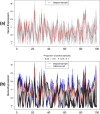DepthTools: an R package for a robust analysis of gene expression data
- PMID: 23885712
- PMCID: PMC3750619
- DOI: 10.1186/1471-2105-14-237
DepthTools: an R package for a robust analysis of gene expression data
Abstract
Background: The use of DNA microarrays and oligonucleotide chips of high density in modern biomedical research provides complex, high dimensional data which have been proven to convey crucial information about gene expression levels and to play an important role in disease diagnosis. Therefore, there is a need for developing new, robust statistical techniques to analyze these data.
Results: depthTools is an R package for a robust statistical analysis of gene expression data, based on an efficient implementation of a feasible notion of depth, the Modified Band Depth. This software includes several visualization and inference tools successfully applied to high dimensional gene expression data. A user-friendly interface is also provided via an R-commander plugin.
Conclusion: We illustrate the utility of the depthTools package, that could be used, for instance, to achieve a better understanding of genome-level variation between tumors and to facilitate the development of personalized treatments.
Figures






Similar articles
-
WGCNA: an R package for weighted correlation network analysis.BMC Bioinformatics. 2008 Dec 29;9:559. doi: 10.1186/1471-2105-9-559. BMC Bioinformatics. 2008. PMID: 19114008 Free PMC article.
-
MADE4: an R package for multivariate analysis of gene expression data.Bioinformatics. 2005 Jun 1;21(11):2789-90. doi: 10.1093/bioinformatics/bti394. Epub 2005 Mar 29. Bioinformatics. 2005. PMID: 15797915
-
SILGGM: An extensive R package for efficient statistical inference in large-scale gene networks.PLoS Comput Biol. 2018 Aug 13;14(8):e1006369. doi: 10.1371/journal.pcbi.1006369. eCollection 2018 Aug. PLoS Comput Biol. 2018. PMID: 30102702 Free PMC article.
-
An overview of Spotfire for gene-expression studies.Curr Protoc Bioinformatics. 2004 Sep;Chapter 7:Unit 7.7. doi: 10.1002/0471250953.bi0707s6. Curr Protoc Bioinformatics. 2004. PMID: 18428733 Review.
-
Open source software for the analysis of microarray data.Biotechniques. 2003 Mar;Suppl:45-51. Biotechniques. 2003. PMID: 12664684 Review.
Cited by
-
Band-based similarity indices for gene expression classification and clustering.Sci Rep. 2021 Nov 3;11(1):21609. doi: 10.1038/s41598-021-00678-9. Sci Rep. 2021. PMID: 34732744 Free PMC article.
-
WERFE: A Gene Selection Algorithm Based on Recursive Feature Elimination and Ensemble Strategy.Front Bioeng Biotechnol. 2020 May 28;8:496. doi: 10.3389/fbioe.2020.00496. eCollection 2020. Front Bioeng Biotechnol. 2020. PMID: 32548100 Free PMC article.
References
-
- Golub TR, Slonim DK, Tamayo P, Huard C, Gaasenbeek M, Mesirov JP, Coller H, Loh ML, Downing JR, Caligiuri MA, Bloomfield CD, Lander ES. Molecular classification of cancer: class discovery and class prediction by gene expression monitoring. Science. 1999;286:531–537. doi: 10.1126/science.286.5439.531. - DOI - PubMed
-
- Ross DT, Scherf U, Eisen MB, Perou CM, Rees C, Spellman P, Iyer V, Jeffrey SS, van de Rijn M, Waltham M, Pergamenschikov A, Lee JC, Lashkari D, Shalon D, Myers TG, Weinstein JN, Botstein D, Brown PO. Systematic variation in gene expression patterns in human cancer cell lines. Nat Genet. 2000;24(3):227–235. doi: 10.1038/73432. - DOI - PubMed
-
- Kote-Jarai Z, Matthews L, Osorio A, Shanley S, Giddings I, Moreews F, Locke I, Evans DG, Eccles D, Williams RD, Girolami M, Campbell C, Eeles R. Accurate prediction of BRCA1 and BRCA2 heterozygous genotype using expression profiling after induced DNA damage. Clin Cancer Res. 2006;12:3896–3901. doi: 10.1158/1078-0432.CCR-05-2805. - DOI - PubMed
-
- Jing L, Ng MK, Zeng T. On gene selection and classification for cancer microarray data using multi-step clustering and sparse representation. Adv Adaptative Data Anal. 2011;3(1–2):127–148.
Publication types
MeSH terms
LinkOut - more resources
Full Text Sources
Other Literature Sources

